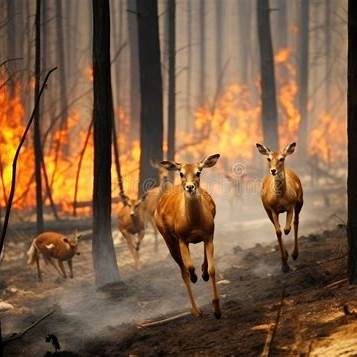UK's Rare Wildlife Facing Extinction Threat Due to Devastating Grass Fires"
- bypari rathore
- 31 July, 2025

WILDLIFE AT RISK OF EXTINCTION
Recent wildfires in the UK have severely impacted rare wildlife, pushing some species closer to extinction. As of mid-April 2025, 112 wildfires have burned over 95 square miles of land, making this the second worst year on record for both area and number of fires. These fires are primarily attributed to prolonged dry and warm weather, with dry vegetation from winter, particularly heather and gorse, becoming highly flammable in spring.
FIRE'S DESTRUCTION
In Lancashire, a fire on Darwen Moor destroyed over 5 km of moorland, affecting breeding sites for ground-nesting birds like curlews and golden plovers. The fire led to a 40% decline in the local curlew population, with many birds unable to rear chicks due to the loss of their nesting sites.
SIMILAR FIRE
Similarly, in Dorset, a wildfire ravaged over 40 acres of heathland across Upton Heath and Canford Heath, killing hundreds of protected animals, including smooth snakes, sand lizards, and Dartford warbler chicks. The fires, believed to be caused by negligence or arson, have had a long-term ecological impact, with recovery expected to take years.

These incidents highlight the vulnerability of the UK's rare wildlife to wildfires, underscoring the need for increased awareness and preventive measures to protect these species from further harm.
WHAT CAN BE DONE
What Can Be Done?
Fire Prevention and Awareness:
Authorities and conservationists are calling for improved fire prevention measures, such as controlled burns, better vegetation management, and heightened public awareness about the risks of starting fires.
Habitat Restoration:
In the aftermath of these fires, restoration efforts are vital to reestablish habitats for wildlife. This can involve replanting native vegetation, removing invasive species, and creating safe spaces for wildlife to thrive.
Policy Changes:
Stronger environmental policies that address climate change and its impacts, as well as support for biodiversity conservation, are seen as key solutions to protecting these fragile ecosystems.
Note: Content and images are for informational use only. For any concerns, contact us at info@rajasthaninews.com.
U.S. Introduces New...
Related Post
Hot Categories
Recent News
Daily Newsletter
Get all the top stories from Blogs to keep track.











